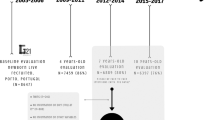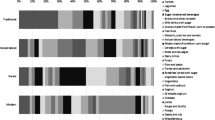Abstract
Background/objectives:
Longitudinal studies investigating dietary patterns (DPs) and their association with childhood overweight/obesity are lacking in Europe. We identified DPs and investigated their association with overweight/obesity and changes in body mass index (BMI) in a cohort of European children.
Subjects/methods:
Children aged 2–10 from eight European countries were recruited in 2007–2008. Food frequency questionnaires were collected from 14 989 children. BMI and BMI z-scores were derived from height and weight and were used to identify overweight/obese children. After 2 years (mean), anthropometric measurements were repeated in 9427 children. Principal component analysis was used to identify DPs. Simplified DPs (SDPs) were derived from DPs. Adjusted odds ratios (ORs) for overweight/obesity with increasing DP intake were estimated using multilevel logistic regression. Associations of BMI change with DP and SDP were assessed by multilevel mixed regression. Models were adjusted for baseline BMI, age, sex, physical activity and family income.
Results:
Four DPs were identified that explained 25% of food intake variance: snacking, sweet and fat, vegetables and wholemeal, and protein and water. After 2 years, 849(9%) children became overweight/obese. Children in the highest vegetables and wholemeal tertile had lower risk of becoming overweight/obese (OR: 0.69, 95% confidence intervals (CIs): 0.54–0.88). Children in the highest SDP tertile of vegetables and wholemeal had similarly lower risk of becoming overweight/obese (OR: 0.64, 95% CIs: 0.51–0.82), and their BMI increased by 0.7 kg/m2 over the study period—significantly less than the increase in the lowest tertile (0.84 kg/m2).
Conclusions:
Our findings suggest that promoting a diet rich in vegetables and wholemeal cereals may counteract overweight/obesity in children.
This is a preview of subscription content, access via your institution
Access options
Subscribe to this journal
Receive 12 print issues and online access
$259.00 per year
only $21.58 per issue
Buy this article
- Purchase on Springer Link
- Instant access to full article PDF
Prices may be subject to local taxes which are calculated during checkout
Similar content being viewed by others
References
Rokholm B, Baker JL, Sorensen TI . The levelling off of the obesity epidemic since the year 1999: a review of evidence and perspectives. Obes Rev 2010; 11: 835–846.
Rito A, Wijnhoven TM, Rutter H, Carvalho MA, Paixao E, Ramos C et al. Prevalence of obesity among Portuguese children (6–8 years old) using three definition criteria: COSI Portugal, 2008. Pediatr Obes 2012; 7: 413–422.
Adamsson V, Reumark A, Fredriksson IB, Hammarstrom E, Vessby B, Johansson G et al. Effects of a healthy Nordic diet on cardiovascular risk factors in hypercholesterolaemic subjects: a randomized controlled trial (NORDIET). J Intern Med 2011; 269: 150–159.
Toselli S, Ventrella AR, Brasili P . Prevalence and tracking of weight disorders in Italian primary school students: a three-year follow-up. Coll Antropol 2012; 36: 63–67.
Kosti RI, Panagiotakos DB . The epidemic of obesity in children and adolescents in the world. Cent Eur J Public Health 2006; 14: 151–159.
de Onis M, Blossner M, Borghi E . Global prevalence and trends of overweight and obesity among preschool children. Am J Clin Nutr 2010; 92: 1257–1264.
Moreno LA, Rodriguez G . Dietary risk factors for development of childhood obesity. Curr Opin Clin Nutr Metab Care 2007; 10: 336–341.
Li M, Dibley MJ, Sibbritt DW, Yan H . Dietary habits and overweight/obesity in adolescents in Xi'an City, China. Asia Pac J Clin Nutr 2010; 19: 76–82.
Moreira P, Santos S, Padrao P, Cordeiro T, Bessa M, Valente H et al. Food patterns according to sociodemographics, physical activity, sleeping and obesity in Portuguese children. Int J Environ Res Public Health 2010; 7: 1121–1138.
Murtaugh MA, Herrick JS, Sweeney C, Baumgartner KB, Guiliano AR, Byers T et al. Diet composition and risk of overweight and obesity in women living in the southwestern United States. J Am Diet Assoc 2007; 107: 1311–1321.
Hu FB . Dietary pattern analysis: a new direction in nutritional epidemiology. Curr Opin Lipidol 2002; 13: 3–9.
Jacques PF, Tucker KL . Are dietary patterns useful for understanding the role of diet in chronic disease? Am J Clin Nutr 2001; 73: 1–2.
Tucker KL . Dietary patterns, approaches, and multicultural perspective. Appl Physiol Nutr Metab 2010; 35: 211–218.
Schulze MB, Hoffmann K, Kroke A, Boeing H . An approach to construct simplified measures of dietary patterns from exploratory factor analysis. Br J Nutr 2003; 89: 409–419.
Ahrens W, Bammann K, Siani A, Buchecker K, De Henauw S, Iacoviello L et al. The IDEFICS cohort: design, characteristics and participation in the baseline survey. Int J Obes 2011; 35 (Suppl 1), S3–S15.
Huybrechts I, Bornhorst C, Pala V, Moreno LA, Barba G, Lissner L et al. Evaluation of the children’s eating habits questionnaire used in the IDEFICS study by relating urinary calcium and potassium to milk consumption frequencies among European children. Int J Obes 2011; 35 (Suppl 1), S69–S78.
Lanfer A, Hebestreit A, Ahrens W, Krogh V, Sieri S, Lissner L et al. Reproducibility of food consumption frequencies derived from the children’s eating habits questionnaire used in the IDEFICS study. Int J Obes 2011; 35 (Suppl 1), S61–S68.
Bel-Serrat S, Mouratidou T, Pala V, Huybrechts I, Bornhorst C, Fernandez-Alvira JM et al. Relative validity of the children’s eating habits questionnaire-food frequency section among young European children: the IDEFICS Study. Public Health Nutr 2013; 4: 1–11.
Valeria P, Lauren L, Antje H, Karin B, Lucia R, Sabina S . Presentation of food frequency questionnaire. In: Bammann K, Ahrens W eds Measurement Tools for a Health Survey on Nutrition, Physical Activity and Lifestyle in Children: The European IDEFICS Study. Springer: New York, NY, USA, 2012.
Cole TJ, Freeman JV, Preece MA . British 1990 growth reference centiles for weight, height, body mass index and head circumference fitted by maximum penalized likelihood. Stat Med 1998; 17: 407–429.
Cole TJ, Bellizzi MC, Flegal KM, Dietz WH . Establishing a standard definition for child overweight and obesity worldwide: international survey. BMJ 2000; 320: 1240–1243.
Comrey AL . Factor-analytic methods of scale development in personality and clinical psychology. J Consult Clin Psychol 1988; 56: 754–761.
Richter A, Heidemann C, Schulze MB, Roosen J, Thiele S, Mensink GB . Dietary patterns of adolescents in Germany: associations with nutrient intake and other health related lifestyle characteristics. BMC Pediatr 2012; 12: 35.
Craig LC, McNeill G, Macdiarmid JI, Masson LF, Holmes BA . Dietary patterns of school-age children in Scotland: association with socio-economic indicators, physical activity and obesity. Br J Nutr 2010; 103: 319–334.
Northstone K, Emmett P . Multivariate analysis of diet in children at four and seven years of age and associations with socio-demographic characteristics. Eur J Clin Nutr 2005; 59: 751–760.
Kourlaba G, Panagiotakos DB, Mihas K, Alevizos A, Marayiannis K, Mariolis A et al. Dietary patterns in relation to socio-economic and lifestyle characteristics among Greek adolescents: a multivariate analysis. Public Health Nutr 2009; 12: 1366–1372.
Oellingrath IM, Svendsen MV, Brantsaeter AL . Tracking of eating patterns and overweight: a follow-up study of Norwegian schoolchildren from middle childhood to early adolescence. Nutr J 2011; 10: 106.
Aranceta J, Perez-Rodrigo C, Ribas L, Serra-Majem L . Sociodemographic and lifestyle determinants of food patterns in Spanish children and adolescents: the enKid study. Eur J Clin Nutr 2003; 57 (Suppl 1), S40–S44.
Patterson E, Warnberg J, Kearney J, Sjostrom M . The tracking of dietary intakes of children and adolescents in Sweden over six years: the European Youth Heart Study. Int J Behav Nutr Phys Act 2009; 6: 91.
Mikkila V, Rasanen L, Raitakari OT, Pietinen P, Viikari J . Consistent dietary patterns identified from childhood to adulthood: the cardiovascular risk in Young Finns Study. Br J Nutr 2005; 93: 923–931.
Odegaard AO, Koh WP, Yuan JM, Gross MD, Pereira MA . Western-style fast food intake and cardio-metabolic risk in an Eastern country. Circulation 2012; 126: 182–188.
Popkin BM . Global nutrition dynamics: the world is shifting rapidly toward a diet linked with noncommunicable diseases. Am J Clin Nutr 2006; 84: 289–298.
Shao Q, Chin KV . Survey of American food trends and the growing obesity epidemic. Nutr Res Pract 2011; 5: 253–259.
Mollard RC, Wong CL, Luhovyy BL, Anderson GH . First and second meal effects of pulses on blood glucose, appetite, and food intake at a later meal. Appl Physiol Nutr Metab 2011; 36: 634–642.
Boeing H, Bechthold A, Bub A, Ellinger S, Haller D, Kroke A et al. Critical review: vegetables and fruit in the prevention of chronic diseases. Eur J Nutr 2012; 51: 637–663.
Izadpanah A, Barnard RJ, Almeda AJ, Baldwin GC, Bridges SA, Shellman ER et al. A short-term diet and exercise intervention ameliorates inflammation and markers of metabolic health in overweight/obese children. Am J Physiol Endocrinol Metab 2012; 303: E542–E550.
Abdelkafi KA, Younes K, Gabsi Z, Bouslah A, Maalel I, Maatouk EM et al. Risk factors of children overweight and obesity. Tunis Med 2012; 90: 387–393.
Heo M, Kim RS, Wylie-Rosett J, Allison DB, Heymsfield SB, Faith MS . Inverse association between fruit and vegetable intake and BMI even after controlling for demographic, socioeconomic and lifestyle factors. Obes Facts 2011; 4: 449–455.
Grant R, Bilgin A, Zeuschner C, Guy T, Pearce R, Hokin B et al. The relative impact of a vegetable-rich diet on key markers of health in a cohort of Australian adolescents. Asia Pac J Clin Nutr 2008; 17: 107–115.
Ritchie LD, Spector P, Stevens MJ, Schmidt MM, Schreiber GB, Striegel-Moore RH et al. Dietary patterns in adolescence are related to adiposity in young adulthood in black and white females. J Nutr 2007; 137: 399–406.
Rolland-Cachera MF, Deheeger M, Akrout M, Bellisle F . Influence of macronutrients on adiposity development: a follow up study of nutrition and growth from 10 months to 8 years of age. Int J Obes Relat Metab Disord 1995; 19: 573–578.
Johnson L, Mander AP, Jones LR, Emmett PM, Jebb SA . Energy-dense, low-fiber, high-fat dietary pattern is associated with increased fatness in childhood. Am J Clin Nutr 2008; 87: 846–854.
Jackson EA, Eagle T, Leidal A, Gurm R, Smolarski J, Goldberg C et al. Childhood obesity: a comparison of health habits of middle-school students from two communities. Clin Epidemiol 2009; 1: 133–139.
Ferreira SR, Lerario DD, Gimeno SG, Sanudo A, Franco LJ . Obesity and central adiposity in Japanese immigrants: role of the Western dietary pattern. J Epidemiol 2002; 12: 431–438.
Agras WS, Hammer LD, McNicholas F, Kraemer HC . Risk factors for childhood overweight: a prospective study from birth to 9.5 years. J Pediatr 2004; 145: 20–25.
Acknowledgements
The authors gratefully acknowledge the children and parents who participated in IDEFICS, and Don Ward who helped with the English. The study is part of the IDEFICS project and is published on behalf of the IDEFICS European Consortium (http://www.idefics.eu). This work was supported by the European Community’s Sixth RTD Framework Programme Contract No. 016181 (FOOD).
Author information
Authors and Affiliations
Corresponding author
Ethics declarations
Competing interests
The authors declare no conflicts of interest.
Rights and permissions
About this article
Cite this article
Pala, V., Lissner, L., Hebestreit, A. et al. Dietary patterns and longitudinal change in body mass in European children: a follow-up study on the IDEFICS multicenter cohort. Eur J Clin Nutr 67, 1042–1049 (2013). https://doi.org/10.1038/ejcn.2013.145
Received:
Revised:
Accepted:
Published:
Issue Date:
DOI: https://doi.org/10.1038/ejcn.2013.145
Keywords
This article is cited by
-
Maternal determinants of dietary patterns in infancy and early childhood in the Growing up in New Zealand cohort
Scientific Reports (2023)
-
Dietary patterns and cognitive achievement among school children in socio-cultural context, a case of Montevideo, Uruguay
European Journal of Nutrition (2023)
-
Selection of key indicators for European policy monitoring and surveillance for dietary behaviour, physical activity and sedentary behaviour
International Journal of Behavioral Nutrition and Physical Activity (2021)
-
Dietary patterns are associated with central adiposity and carotid intima-media thickness in children and adolescents with congenital heart disease
European Journal of Nutrition (2021)
-
Secular trend in dietary patterns of Iranian adults from 2006 to 2017: Tehran lipid and glucose study
Nutrition Journal (2020)



